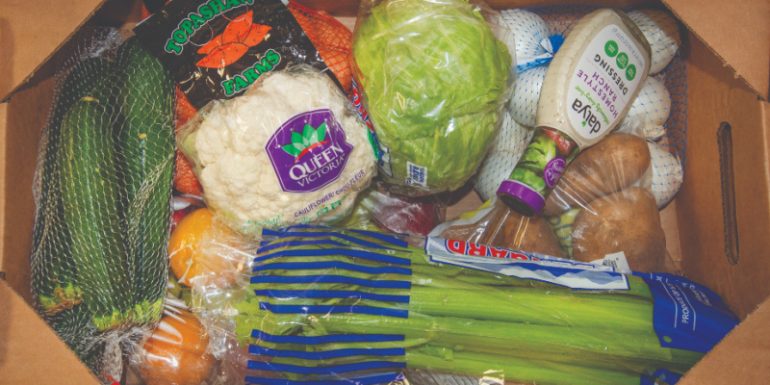By Amanda N. Wegner
Editor’s note: This article first appeared in 2020 during the Covid-19 pandemic, which affected the protocols in place for volunteering or visiting the Walworth County Food & Diaper Bank. For the most up-to-date information on the systems and operations in place today, visit wcfdb.com.
Food insecurity doesn’t discriminate, and many people are just one unfortunate event — a job loss, the loss of a loved one, a medical crisis — away from it. And some, particularly children and seniors, may be at greater risk of hunger than others. That’s why the work of the Walworth County Food & Diaper Bank is so critical.
“Anyone can end up in a situation where they just need a little help,” says Volunteer Managing Director Susan Hughes. “Hunger exists in every city of the United States, and Walworth County is no different. We are working hard to close the gap on hunger.”
THE NEW FACE OF HUNGER
The organization provides the people of Walworth County with nutritional supplemental food, diapers and feminine hygiene products without regard to age, race, creed, color, national origin, physical or developmental disability.
According to United Way, 42% of Wisconsin residents are employed but income constrained, and in Walworth County, this is the case for 44% of its residents. This is the new face of hunger: employed individuals who struggle to afford basic necessities.
In 2019, the Walworth County Food & Diaper Bank served 3,418 unique individuals, representing 1,399 households. Many are seniors. “We serve a disproportionate number of senior citizens who need assistance and the numbers of seniors in need in Walworth County continues to grow,” says Hughes. The organization is the single distribution center for the county’s Senior Stock Box program, which provides an additional box of food each month to 415 seniors enrolled in the program.
The organization is also the only member of the National Alliance for Period Supplies and the National Diaper Bank Network in the area. People can come to the food pantry once a month for groceries and diapers and as often as they need for milk, says Hughes. “However,” she adds, “if someone is out of food, we will help them regardless of when they were here last.”
The pantry was designed as a small market, also called a “choice pantry” until the pandemic forced a change to a drive-through format. Now, groceries are preselected and packed based on family size.
While the income requirement for U.S. Department of Agriculture commodities and diapers is set at 300% of the federal poverty level, the pantry does not require proof of income, instead, says Hughes, it is self-verified based on what the individual reports. A person in need only has to come to the facility, show a photo ID, and they will receive a supply of approximately 10 days to two weeks’ worth of food. On their first visit, they also need to provide a piece of mail like a utility bill, showing that they reside in Walworth County.
The Walworth County Food & Diaper Bank also extends beyond its Elkhorn location. “Our reach goes beyond the walls of the food pantry as we also provide food and services to as many as nine other food pantries in Walworth County,” explains Hughes.
The organization collaborates with Kenosha, Racine and Rock counties to source food and share surplus inventories. It also participates in several federal food programs to supplement the food it purchases; helps support local farms; and works with critical partners such as the Aging and Disability Resource Center, Women, Infants and Children Program and others to provide nutrition-education materials, SNAP benefit outreach services and more.
POWERED BY VOLUNTEERS AND DONATIONS
The Walworth County Food & Diaper Bank is 100% reliant on its volunteer base — there are no paid employees.
Trish and Paul Schmelzer are longtime volunteers. Trish recalls showing up at the pantry shortly after it opened to see what opportunities were available, and Paul says he tagged along with Trish and ultimately found a place with the organization as well.
“It’s really a big, big part of our lives,” says Trish, who helped start the organization’s diaper and feminine hygiene programs. “Getting out of your comfort zone and actually helping someone who needs help is a very rewarding thing. The people we have worked with at the pantry and clients have become like a family to us.”
The organization is not recruiting volunteers at present, but it has high need for funding for food. “There are more people coming to the pantry for assistance and less food being ‘rescued’ at retail,” says Hughes.
Funding for the organization comes from the community and gracious donors throughout Walworth County. Only 10% of the food is provided by the The Emergency Federal Assistance Program run by USDA — the balance is paid for by the community.
“We operate on a budget with very little overhead,” says Hughes. “We rely on grants and the generosity of those individuals and families who support our mission.”
Monetary donations are even more important right now as the pandemic has made fundraising difficult for the organization; three scheduled events in 2020 have been cancelled due to the virus.
Financial donations go further for the organization than food donations thanks to discounts, cost-sharing and other incentives. For instance, the organization pays $0.19 per pound, on average, for food from Feeding America, an association of affiliated food banks that sources, warehouses and provides food.
The organization also receives food from many other sources and often at large discounts. And with ample on- site storage, they can take advantage of good values and pricing when they come along. “So we can make every dollar we receive go a long way!” says Hughes.
REINVENTING THEIR PROCESSES
The pandemic has changed the pantry in many ways. “The virus has caused us to change everything we are doing in terms of food acquisition and food distribution,” says Hughes.
For instance, a decision was made that volunteers would no longer visit stores such as Walmart, Aldi and other retailers twice a week to obtain food. This was because excess food donations were no longer consistently available, and because it was no longer safe for volunteers and guests to distribute food products that had been previously handled so many times. Instead, the pantry is now purchasing food through Feeding America and other distributors, manufacturers and farmers.
They are also no longer able to reuse plastic bags that they once recycled. Now they are forced to purchase new packaging material in bulk. This all means greater costs to an organization that is already on a tight budget and run completely by volunteers.
In addition, the organization has moved food distribution to entirely no-contact for the safety of all. Volunteers register guests through a secure, electronic system and the drive-through format allows volunteers to load groceries into guests’ trunks.
The electronic system has been a great assistance throughout the pandemic as it has allowed volunteers to identify those who have not come in for food for varying lengths of time. “Wellness calls were made to over 300 households to assure residents of the safety measures we were taking and that the pantry remained open and safe,” says Hughes.
WELL PREPARED FOR THE FUTURE
The pandemic has also forced the pantry to change how it views security as it relates to income. “Many people who are coming for help now have had their world turned upside down, going from being self-reliant to depending on the generosity of others. We want their experience with us to be as dignified as possible.”
As the pandemic continues, Hughes says it’s difficult to know what to expect, but she knows Walworth County Food & Diaper Bank is “well prepared to continue in this fashion for the foreseeable future.”
“Not only is this process safe for both the guests and volunteers, it is extremely efficient,” she says. “We can easily provide food to as many people who may need help.”





